If you’re a government keen to be seen to be getting immigration down, the headline stats in this quarter’s figures from the Home Office – to year ending March 2024 – make for uncomfortable reading.
Over the year there were 125.5 million arrivals – 11 per cent more than the preceding year, and there were 3.4 million entry clearance visas granted – 7 per cent higher than prior to the onset of the pandemic.
That will explain why the Home Office brought forward publication of its monthly figures yesterday – allowing it to point out that visa applications across key routes have fallen by a quarter in the first 4 months of 2024, highlighting that the ban on international PGTs being able to bring dependants has resulted in 79 per cent fewer dependent applications in the first 4 months of 2024.
There was even a press release to go with it:
Clamping down on institutions which undermine the UK’s reputation by selling immigration not education” has also meant that there were more than 30,000 fewer student visa applications made between January to April 2024 compared to the same period in 2023.
That has doubtless helped smooth the path for the announcement that the graduate route will stay – albeit with some extra twiddles (notably, a more rigorous enforcement of CAS to completion minimums) to ensure the government still sounds tough. Dodgy agents are to have their business model “smashed”, etc.
Down, but still up
In the student route specifically, there were 446,924 sponsored study visas granted to students in the year ending March 2024 – 6 per cent fewer than the previous year, but 66 per cent higher than 2019, prior to the pandemic and the introduction of the graduate route:
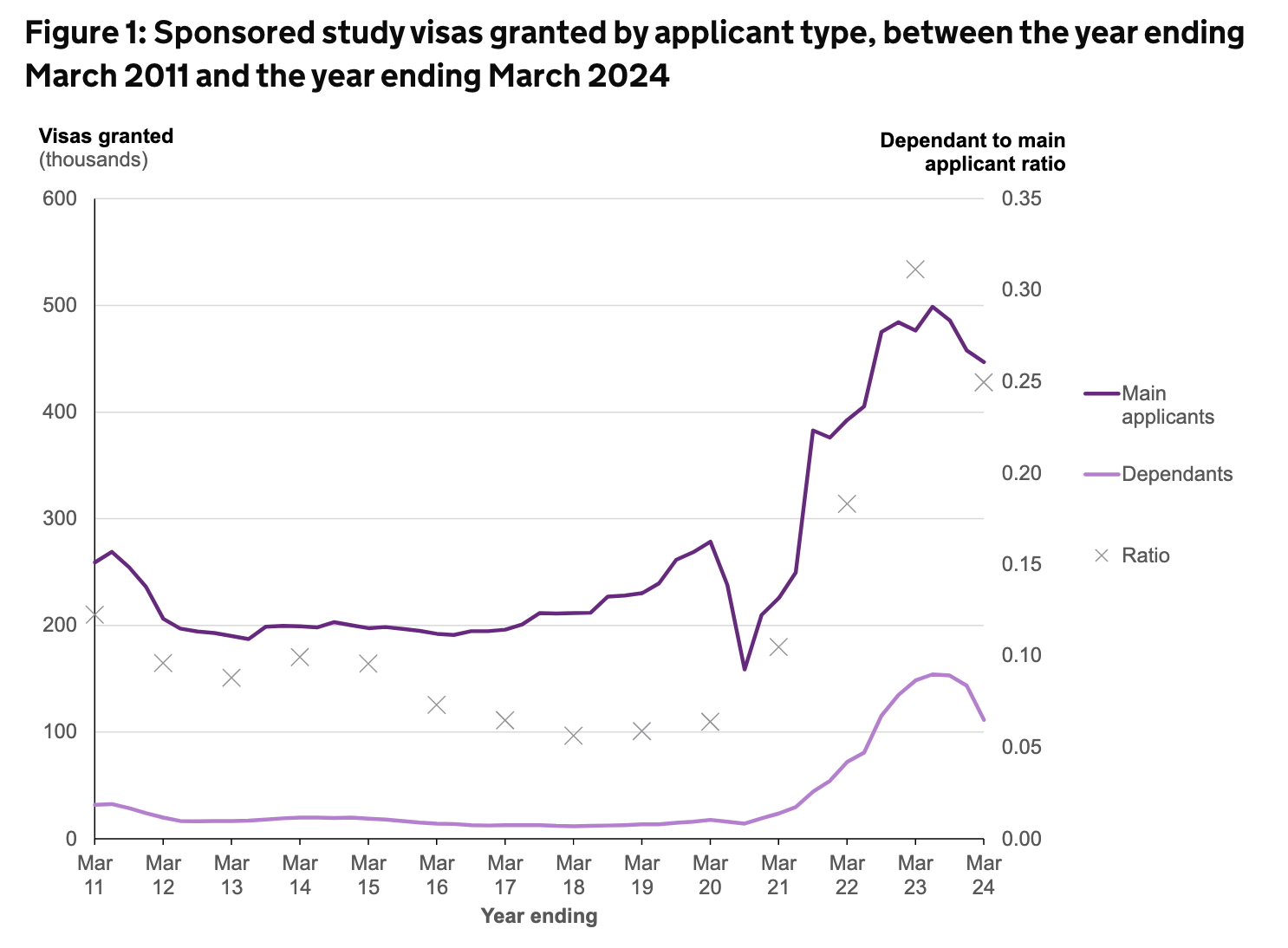
We don’t usually learn about level of study – but this time we have numbers suggesting that two-thirds of student visas were for a masters level course in the year.
Country-by-country, most of the increase in main applicants between 2019 and 2023 has been from Indian and Nigerian nationals, but numbers for these nationalities have fallen in the latest year – by 16 per cent and 38 per cent respectively:
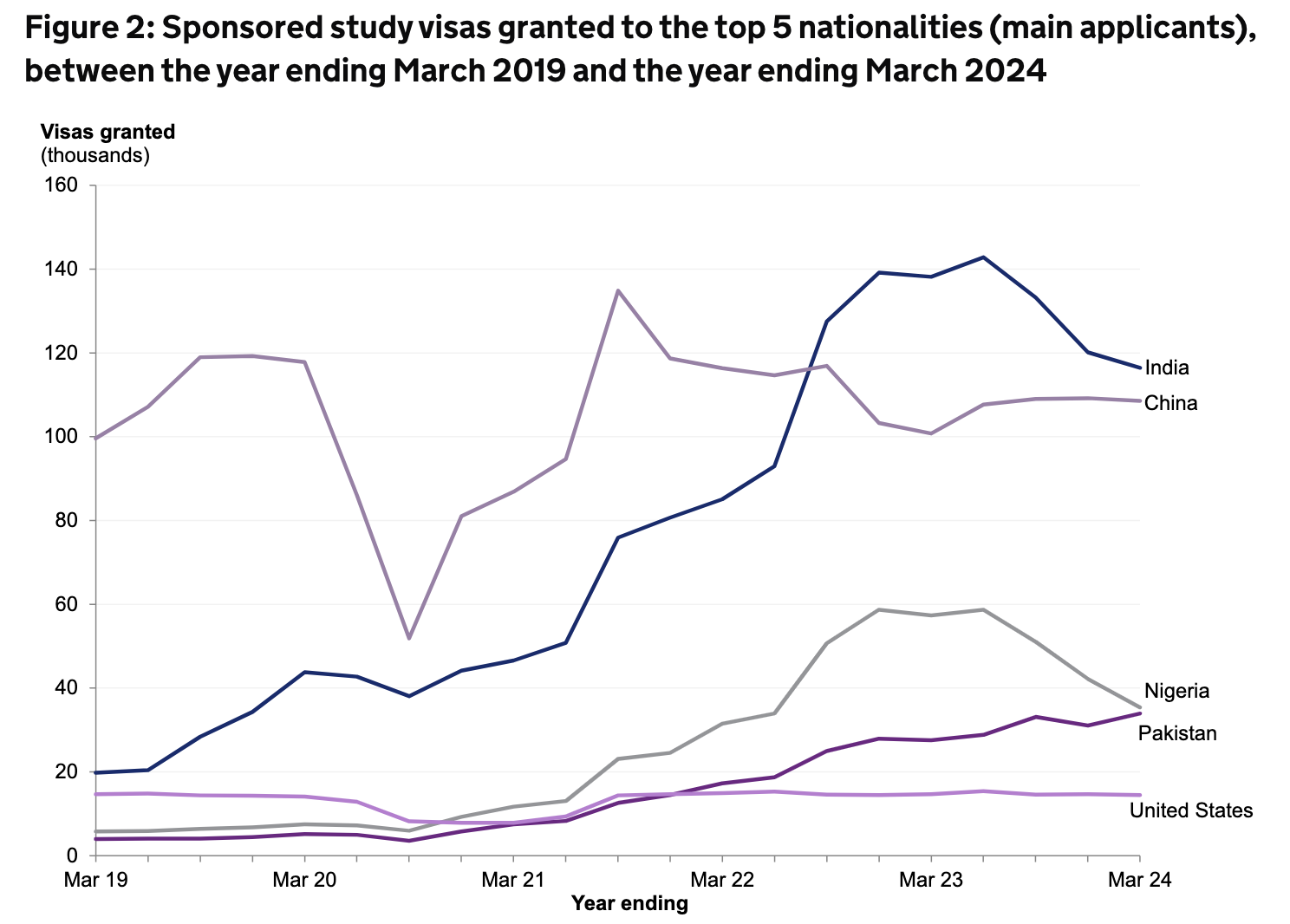
Chinese nationals were the second most common nationality granted sponsored study visas (108,582), accounting for 24 per cent of the total – with the majority (63,027, 58 per cent) also studying at masters level.
That growth in visas for PGTs has been oft-discussed on the site, but that new data by course type from the Home Office illustrates the rise well:
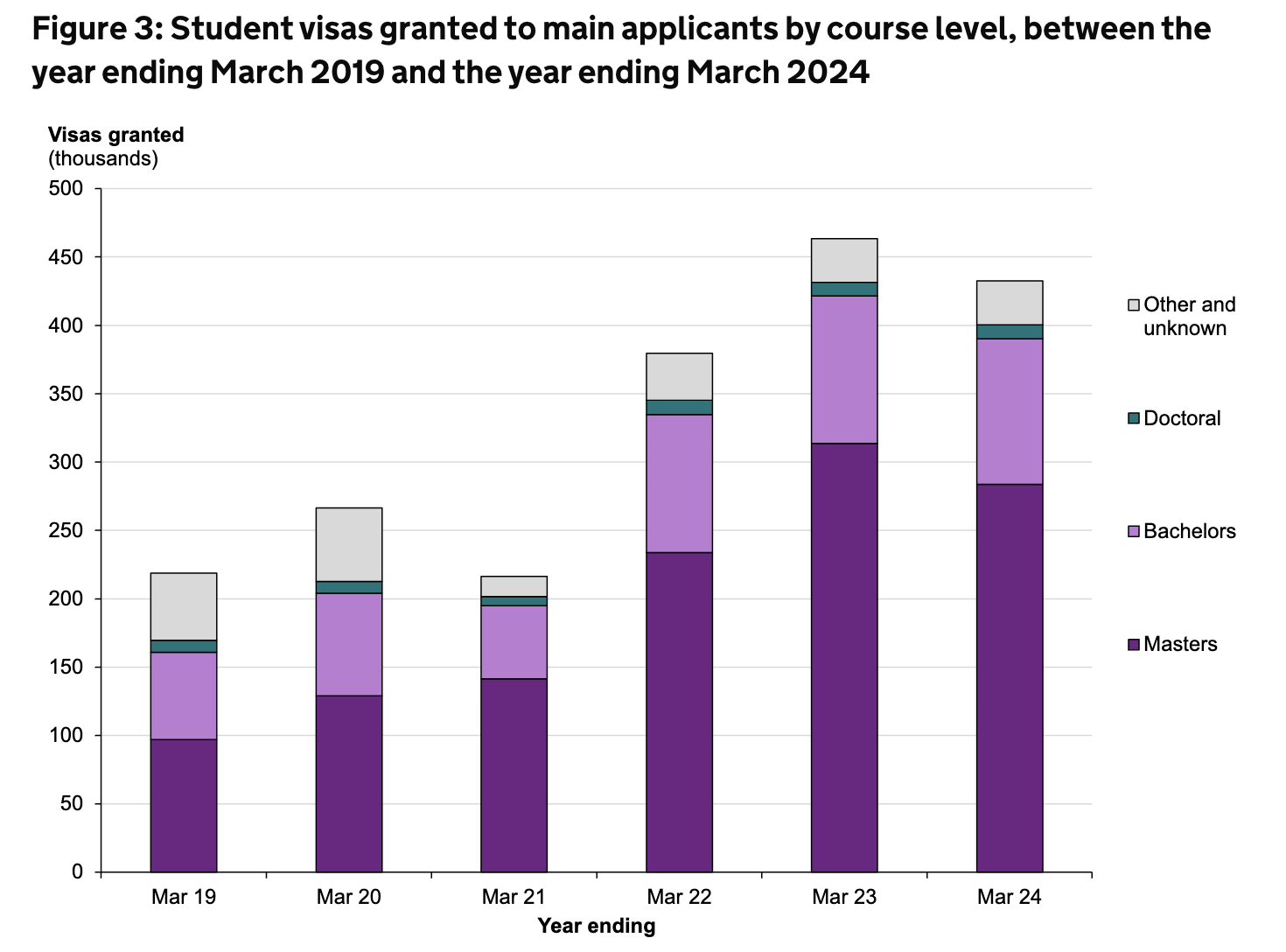
Stay another day
In terms of graduate route take-up, grants decreased by 38 per cent to 35,175, compared with the year ending March 2023 (56,736).
We’re also reminded that most international students do not remain in the UK indefinitely – since 2007, fewer than 10 per cent of people who came to study in the UK had indefinite leave to remain 10 years later (compared to over 20 per cent who came for work and over 80 per cent for family reasons).
That’s a stat many like to hang on to when arguing that international students should be taken out of net migration figures.
But it’s the 2020 cohort that matters – given it’s the first for which students of any course length could transfer directly to the graduate route. Of that cohort, 57 per cent still held valid or indefinite leave 3 years later at the end of 2023, compared to 39 per cent in the 2019 cohort and 34 per cent for students arriving between 2011 and 2018.
The quarter
As ever, the full-year figures tell one smoothed story – but it’s in the data weeds of the quarter where ministers will be looking for justifications for not killing off the graduate route, and where universities will be looking for clues on where numbers will go next.
This chart illustrates the quarter-by-quarter thing – year-on-year this quarter just gone saw a drop of 10,591 visas issued – a 22 per cent decline – with refusals creeping up too as UKVI evidently gets tougher over scrutiny of applications:
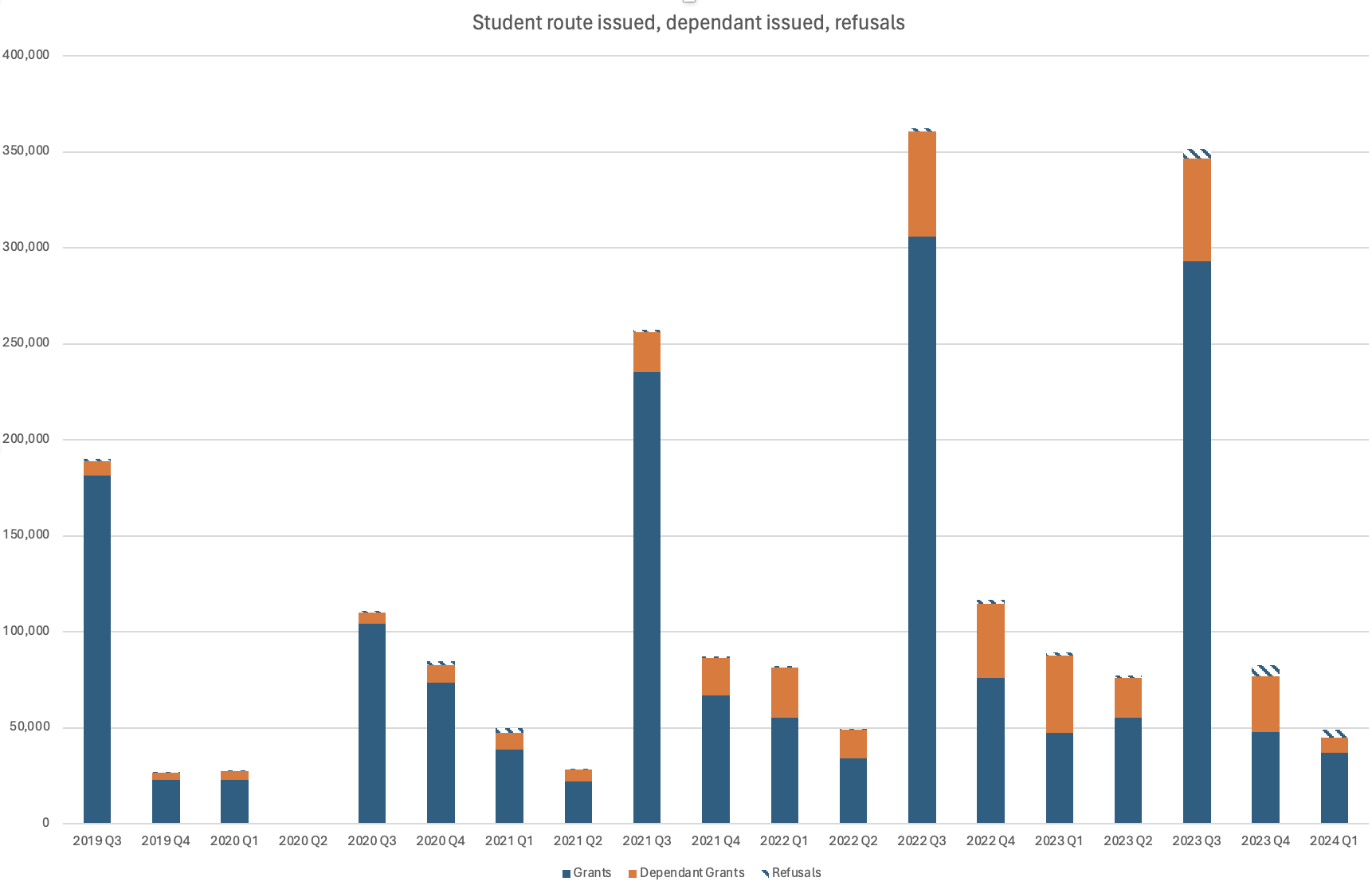
Depending on the country, the decline (or, in the case of Pakistan, the continued growth) is more pronounced. Here’s the most recent quarter compared to last year for the biggest countries:
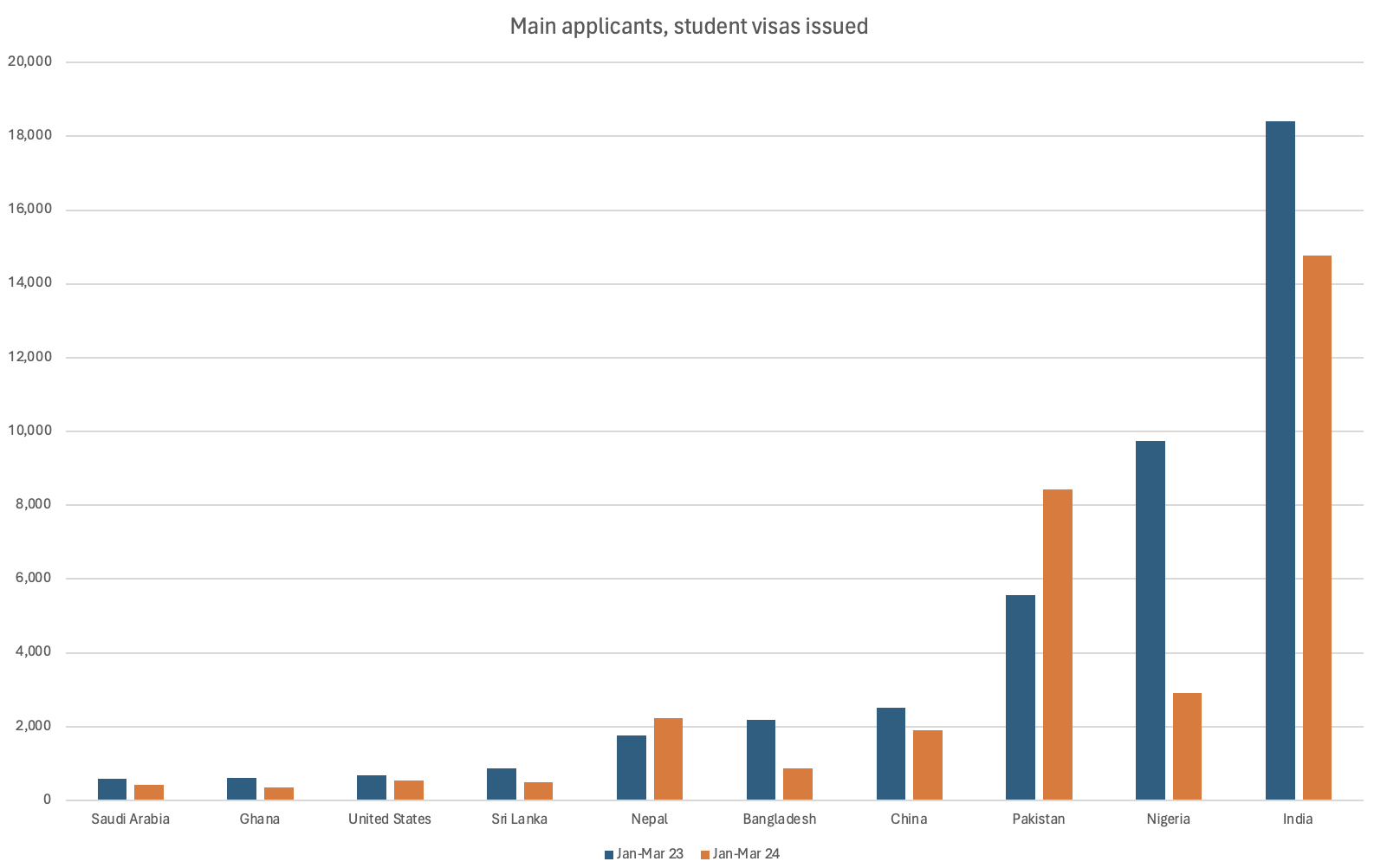
Back of the net
Separately, the Office for National Statistics (ONS) has published both an update on research work to understand the contribution of international students to net migration figures, and a more general update to its international migration research.
The good news for those arguing that students come and then go is that for the year ending December 2023, net migration of non-EU international students decreased, falling to 247,000 compared with its estimate of 328,000 in the YE December 2022. This includes those who emigrated but had transitioned onto a different visa type during their time in the UK.
Causing that is an increase in emigration and a slight decrease in immigration – in the year ending December 2023, 133,000 non-EU international students left the UK (up 42,000 from the YE December 2022), and 379,000 arrived in the UK on a study-related visa (down 40,000 from the YE December 2022):
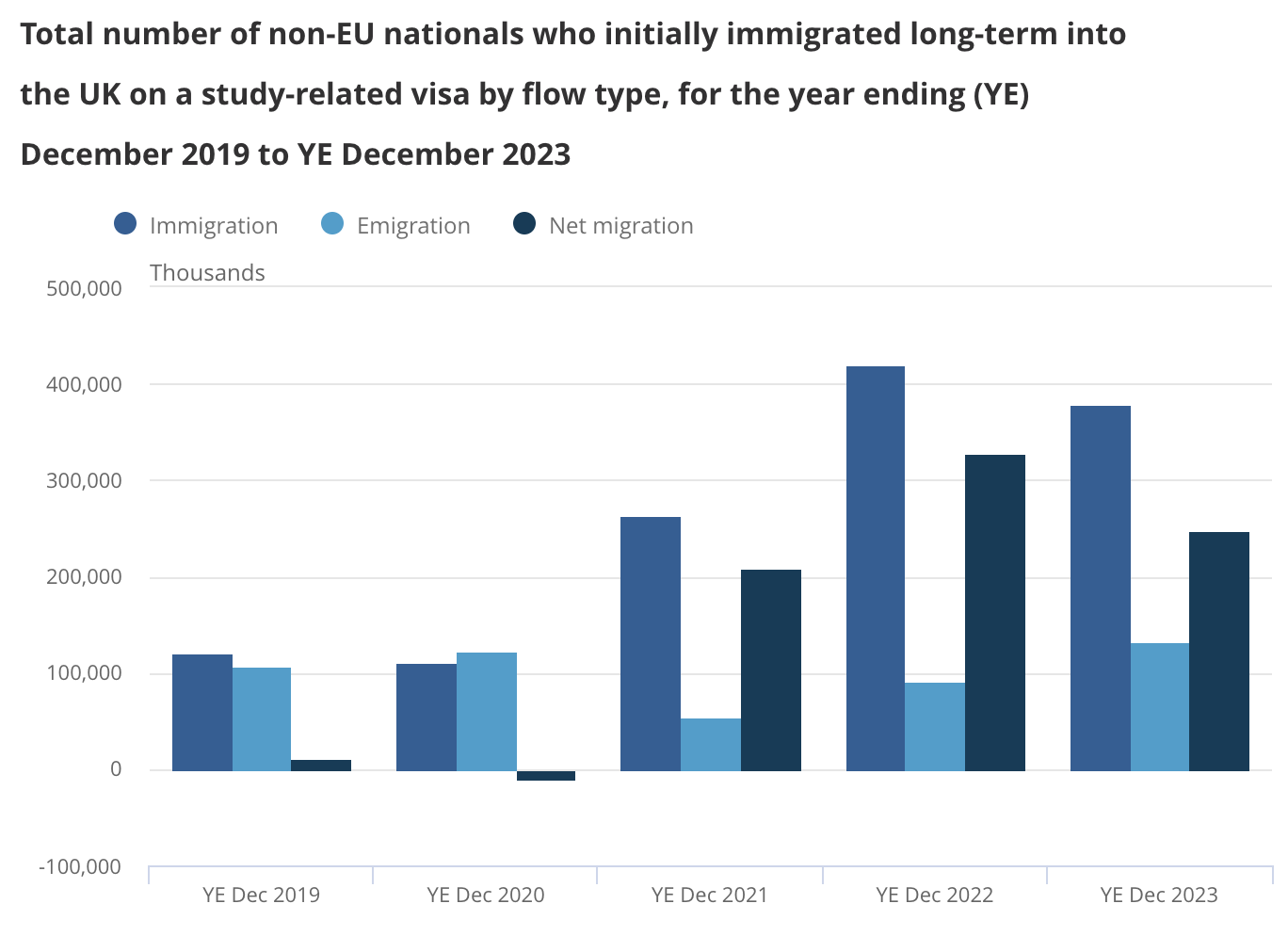
Less good news for those making those arguments (who may or may not be relying on historical figures pre-Graduate Route and the international PGT explosion) is that more international students are staying in the UK longer and transitioning to other visa types, rather than leaving at the end of their studies.
40 per cent of those who arrived in the year ending December 2021 transitioned within two years of arrival, compared with just 5 per cent of those who arrived in the YE December 2018.
There are also stats on non-EU international students who remain in the UK after completing their studies that do so to work – stats that are central to the “sell education not immigration” charge.
Of those who arrived in the year ending December 2022, 22,800 (5 per cent) transitioned to a work visa within one year of arrival into the UK. That’s a substantial increase from the 1,700 (1 per cent) of the 2018 cohort and the 800 (less than 1 per cent) of the 2019 cohort. The recently introduced requirement that students complete their course before doing so will be dragging that figure down now too.
One thing that we don’t seem to have seen before that would inform infrastructure support planning – both inside universities and in the wider community – is gender and age of those arriving on study visas. Frustratingly, ONS’ numbers don’t split out dependants and main applicants, but they’re fascinating nonetheless. Here’s pre-graduate route:
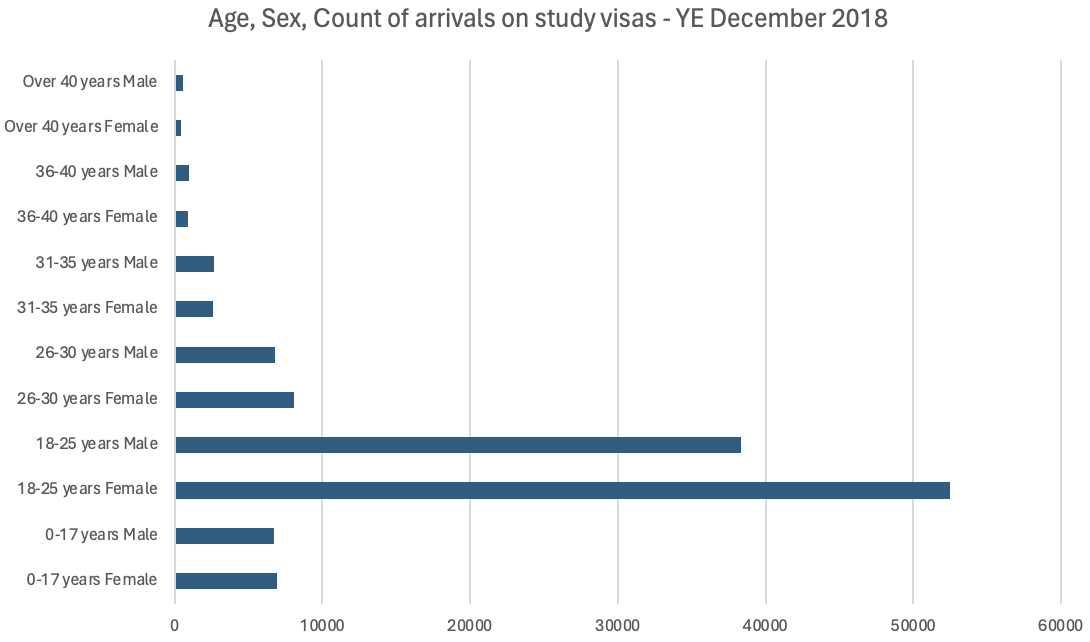
And here’s post:
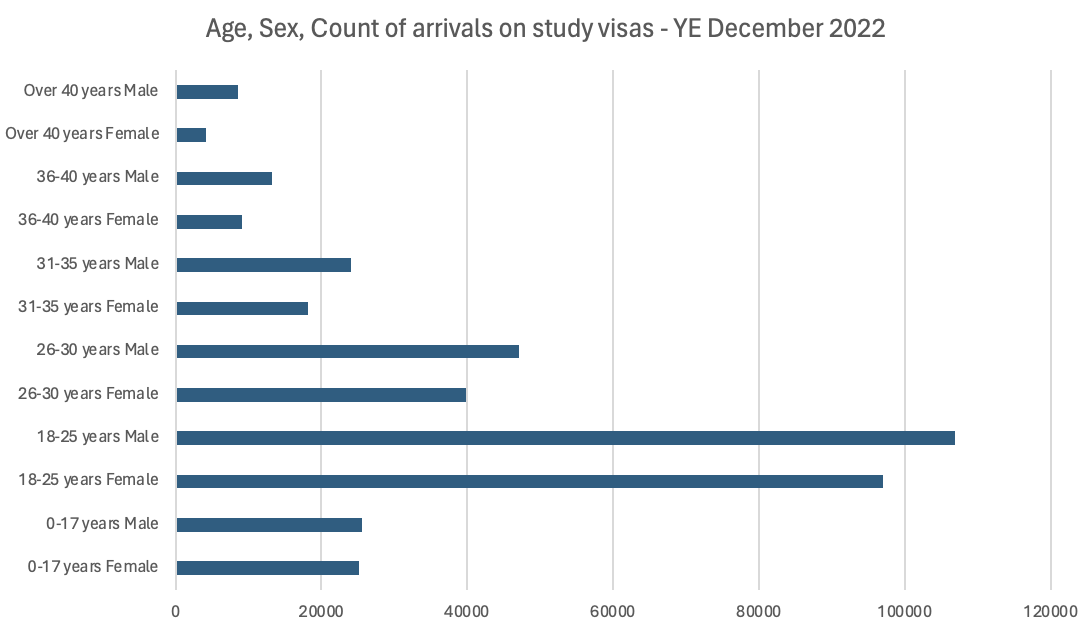
Avoiding boom and bust
One issue with the way that HO figures are full-year smoothed, coupled with the length of time that students stay (either on a UG degree or onto the graduate route) is that when things were growing, it took time for students to show up in migration figures – net or not.
That might explain the “political lag” between numbers growing so rapidly and ministers needing to be seen to do something about it.
Now there is the opposite issue – as overall numbers fall sharply, it takes time for that to show up in smoothed numbers too – leading to the danger of “over-correction” through either formal levers (legislative change) or informal levers (leaning on UKVI to more heavily enforce what’s there) available to ministers via the immigration system.
As such, what you’d want – and MPs probably need – is both an attempt at impact analysis when a policy change is mooted or introduced, and then a way of tracking whether you were right – the lack of the latter being something MAC’s review of the graduate route was heavily critical of the Home Office over.
Assessing the impact
On impact analysis, it was a year ago to the day that Suella Braverman announced the ban on dependants for international PGTs. That should have triggered an impact assessment from the Home Office.
The secondary legislation appeared two months later on 17 July last year. The accompanying memo said that significant indirect impacts on universities and impacts on the public sector:
…are set out in the Impact Assessment which has been prepared for these Rules changes”
But it wasn’t published – so MPs that could have intervened weren’t given the appropriate information.
Then just before Christmas, James Cleverly announced the review of the graduate route and we got this paper.
It also said that an IA had been produced for changes affecting the student route, but a footnote said:
…the Impact Assessment is still awaiting final Departmental clearances”.
Months have gone by. Then late last month, Caroline Lucas MP asked Tom Pursglove (Minister of State for Legal Migration and Delivery) asked where it was. He replied:
An Impact Assessment has been prepared to accompany the dependant changes to the Student route, announced in May 2023, which came into force in January 2024. The Impact Assessment will be published in due course.
Remember – the original impact assessment for the graduate route was so out (both on numbers and wider impacts) as to be theoretically embarrassing for Home Office officials, compounding the “where was your monitoring” allegation from the MAC.
But at least there was one. Maybe officials undercooked the assessment last year, maybe they overcooked it – but either way it’s hard to think of a reason why MPs and the public would be deprived of an assessment of the impacts of these big policy changes when they are being introduced, other than “we keep looking wrong and out of control”.
Whether one will emerge for the new package of changes that surround the graduate route’s retention is unclear – but again, the danger is that repeated back-of-fag packet “crackdowns” are based only on a need to get through a political cycle, rather than evidenced policy discussions that properly balance public concern for migration with wider economic and educational interests.
Universities, MPs and the public deserve better.












